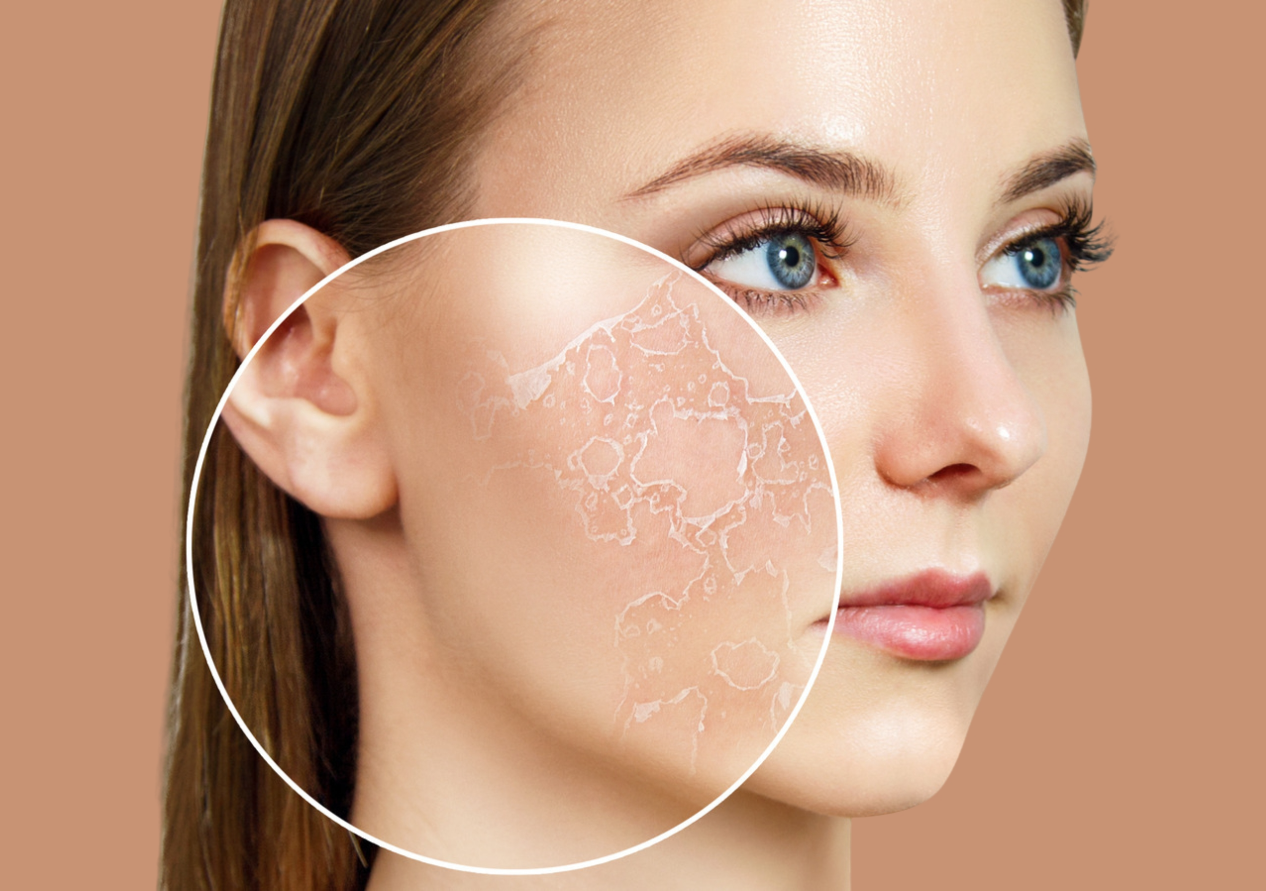
Dehydrated skin can be a real pain, literally and metaphorically. When your skin lacks moisture, it can feel tight, itchy, and show signs of dullness and flakiness. But fret not, as we are here to help you spot and soothe the telltale symptoms of dehydrated skin.
One of the key indicators of dehydrated skin is its overall appearance. If your complexion looks lackluster and feels rough, chances are your skin is lacking hydration. Other common signs include fine lines, redness, and a tight sensation when you touch your face.
In addition to the physical symptoms, your skin might also feel parched and uncomfortable. You may notice a persistent feeling of dryness, even if you regularly moisturize your face.
The good news is that there are plenty of ways to quench your skin’s thirst and restore its natural glow. From adjusting your skincare routine to incorporating hydrating ingredients into your products, we will explore effective strategies to help you combat dehydrated skin.
So, if you’re ready to bid adieu to dryness and say hello to a healthy, hydrated complexion, keep reading for our expert tips and tricks. Your skin will thank you!
Understanding Dehydrated Skin
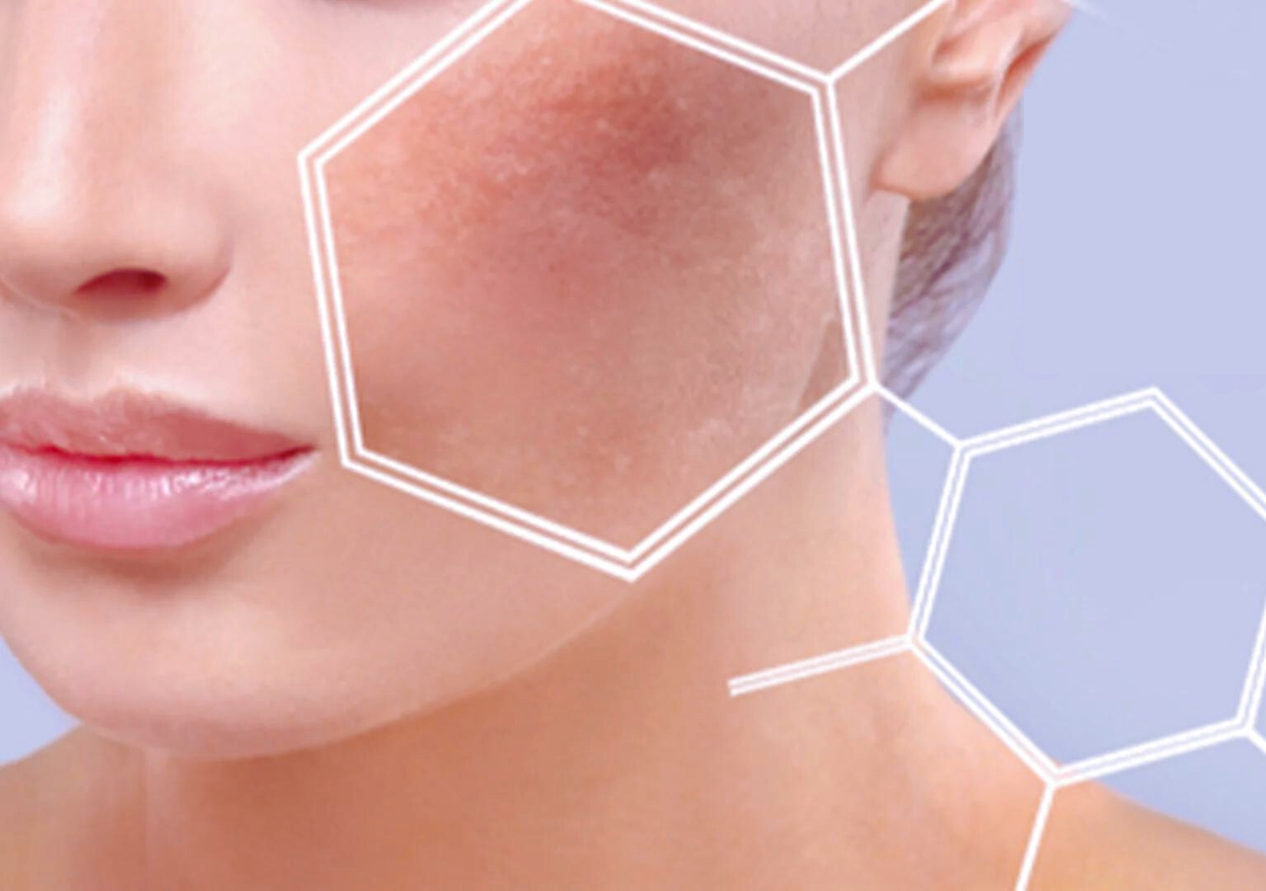
Dehydrated skin is different from dry skin, although they can often be confused. While dry skin is a skin type that lacks oil production, dehydrated skin is a condition that lacks water content. This means that even if you have oily skin, you can still experience dehydrated skin.
Dehydrated skin occurs when the skin’s outermost layer, known as the stratum corneum, loses its ability to retain moisture. This can happen due to various factors such as environmental conditions, lifestyle choices, and skincare habits.
When the stratum corneum is compromised, it allows water to escape from the skin, leading to dryness and a weakened skin barrier. This can make your skin more susceptible to external irritants and can exacerbate existing skin issues such as acne or eczema.
Understanding the difference between dry and dehydrated skin is crucial because the treatment approaches may vary. While dry skin requires more oil-based products to replenish the skin’s natural oils, dehydrated skin needs hydration to restore its moisture balance.
Navigating the complexities of skin hydration can be simpler with a guide to beginner skincare routine, helping you to effectively differentiate and care for dry versus dehydrated skin.
Common Symptoms of Dehydrated Skin
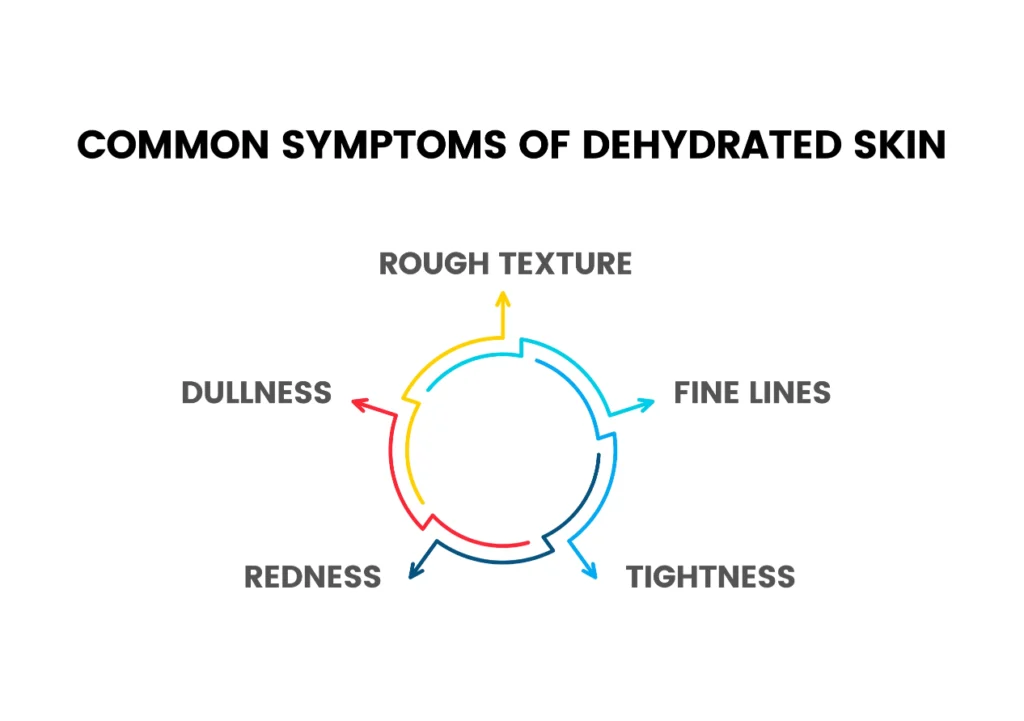
Recognizing the symptoms of dehydrated skin is the first step in addressing the issue effectively. Here are some common signs to look out for:
Dullness
Dehydrated skin often lacks that healthy, radiant glow. If your complexion appears lackluster and lacks vitality, it might be a sign that your skin needs hydration.
Rough Texture
When your skin lacks moisture, it can become rough and uneven in texture. You might notice a bumpy or sandpaper-like feel when you run your fingers over your face.
Fine Lines
Dehydration can accentuate the appearance of fine lines and wrinkles, making them more prominent. If you notice an increase in fine lines, especially around areas prone to dryness like the cheeks or forehead, it could indicate dehydrated skin.
Redness
Dehydrated skin can be more prone to redness and sensitivity. If you notice patches of redness or experience increased sensitivity to skincare products or environmental triggers, it could be a sign of dehydration.
Tightness
A common symptom of dehydrated skin is a tight, uncomfortable sensation. If your skin feels like it’s pulling or stretching when you make facial expressions or touch it, it may be a sign that your skin is lacking hydration.
Recognizing these symptoms is crucial in identifying whether your skin is dehydrated or experiencing another issue. Once you’ve determined that dehydration is the culprit, you can take steps to replenish and restore your skin’s moisture levels.
Causes of Dehydrated Skin
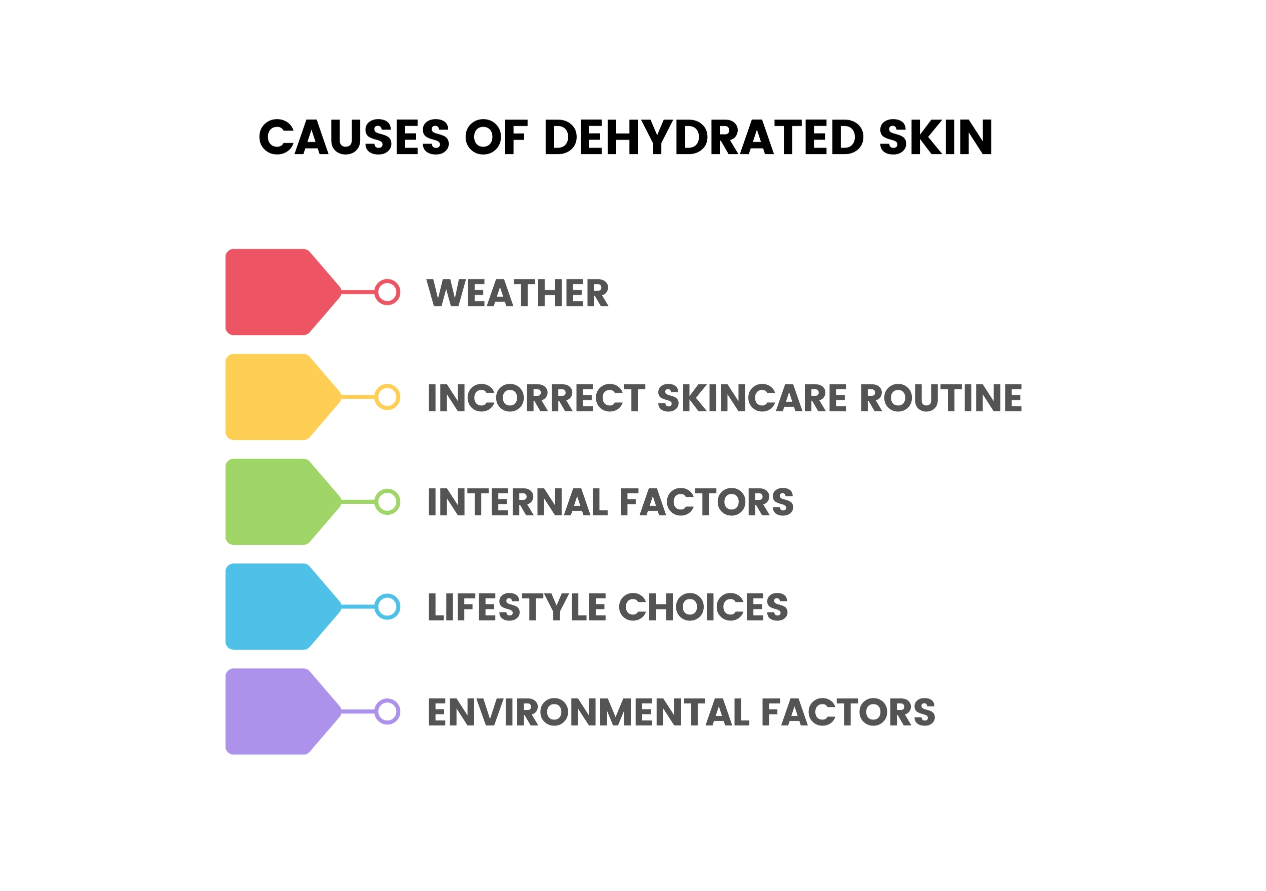
Understanding the causes of dehydrated skin can help you take preventative measures and make the necessary changes to your skincare routine and lifestyle. Here are some common factors that can contribute to dehydrated skin:
Weather
Extreme temperatures, low humidity, and harsh weather conditions can strip your skin of moisture, leading to dehydration. Cold, dry winters and hot, arid summers are often the culprits behind dehydrated skin.
Incorrect Skincare Routine
Using harsh or drying skincare products, over-exfoliating, and not moisturizing adequately can disrupt your skin’s moisture balance and contribute to dehydration. It’s important to choose products that are gentle and hydrating, and to follow a consistent skincare routine.
Internal Factors
Certain health conditions, medications, and hormonal changes can affect your skin’s moisture levels. Conditions like eczema and psoriasis can impair your skin’s ability to retain moisture, while hormonal fluctuations during pregnancy or menopause can also lead to dehydrated skin.
Lifestyle Choices
Lifestyle factors such as smoking, excessive alcohol consumption, and a poor diet can impact your skin’s hydration levels. These habits can deplete essential vitamins and nutrients necessary for healthy skin, leading to dehydration.
Environmental Factors
Exposure to air conditioning, central heating, and pollution can also contribute to dehydrated skin. These factors can sap moisture from your skin and leave it feeling dry and tight.
By identifying the causes of dehydrated skin in your own life, you can take proactive steps to address them and prevent further moisture loss. Now that we know the symptoms and causes of dehydrated skin, let’s explore how to spot the signs and take action.
Understanding what leads to dehydrated skin is just the first step; taking action, such as deciding to book for HydraFacial treatments in Arlington, VA, can significantly help in preventing moisture loss and restoring skin health.
How to Spot the Signs of Dehydrated Skin
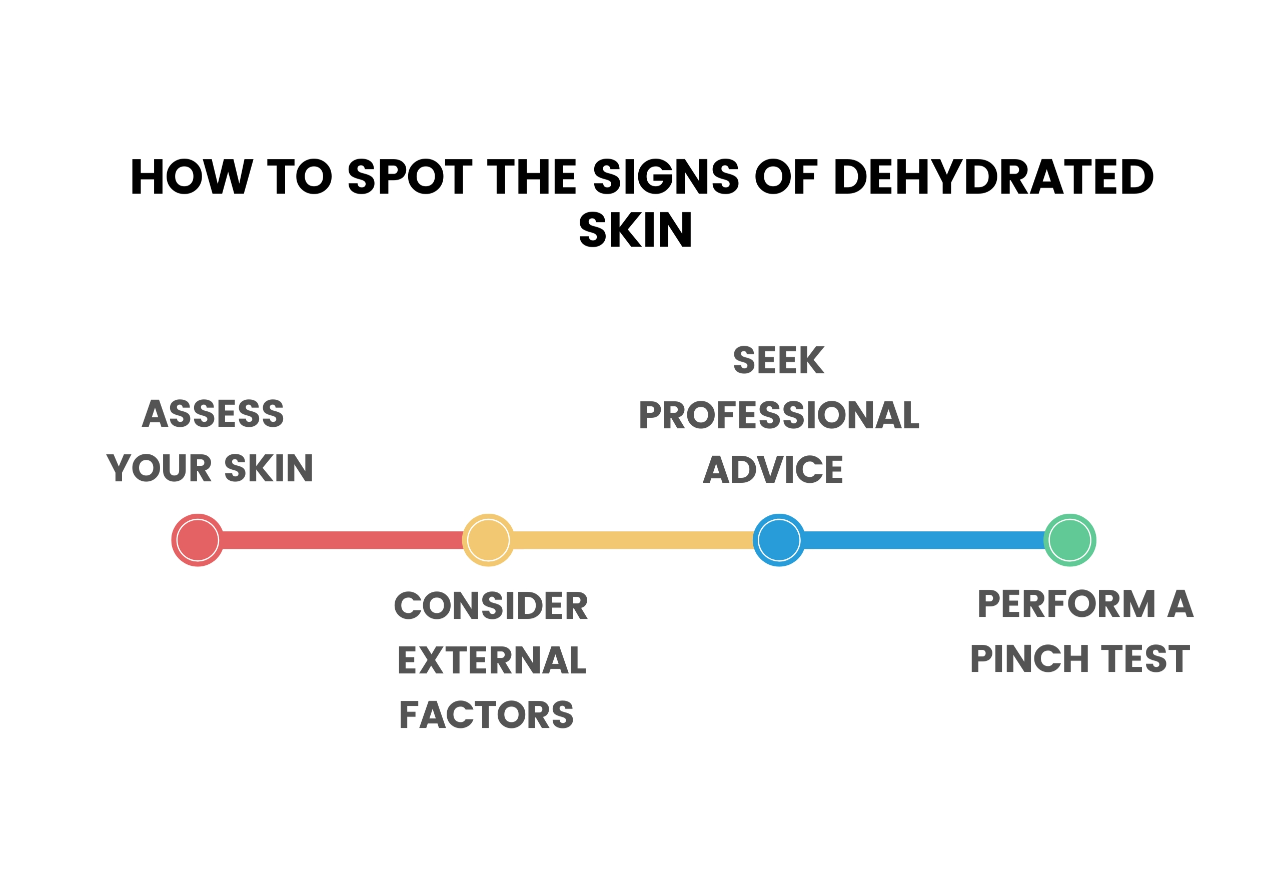
Recognizing the signs of dehydrated skin is essential for finding the right solutions and treatments. Here are some steps you can take to spot the signs of dehydrated skin:
Assess Your Skin
Start by examining your skin’s appearance and texture. Look for signs of dullness, roughness, fine lines, redness, and tightness. Take note of any discomfort or persistent dryness you may be experiencing.
Consider External Factors
Evaluate your lifestyle and environment to identify potential causes of dehydration. Think about weather conditions, skincare routine, and any recent changes in your health or medication.
Seek Professional Advice
If you’re unsure about the condition of your skin or are struggling to identify the signs of dehydration, consider consulting a dermatologist or skincare professional. They can assess your skin’s condition and provide tailored recommendations.
Perform a Pinch Test
A simple way to determine if you have dehydrated skin is to perform a pinch test. Gently pinch a small area of your skin, such as your cheek or forearm. If the skin takes longer to bounce back or retains a crease, it may indicate dehydration.
By following these steps, you can gain a better understanding of whether your skin is dehydrated and take appropriate measures to address the issue. Now let’s dive into a skincare routine specifically designed to combat dehydrated skin.
If the signs of dehydration are puzzling you, it might be time to visit a skincare clinic in Virginia, where professionals can assess your skin’s needs accurately.
Conclusion: Taking care of your skin's hydration needs
Dehydrated skin can be a frustrating condition to deal with, but with the right knowledge and skincare products, you can effectively soothe and hydrate your skin.
Remember to look for skincare products that contain hydrating ingredients such as hyaluronic acid, glycerin, ceramides, aloe vera, and niacinamide. These ingredients work to replenish moisture, improve the skin’s barrier function, and soothe any irritation or redness.
Additionally, it is essential to adjust your skincare routine to prioritize hydration. Cleanse your face with a gentle cleanser, followed by a hydrating toner and serum. Seal in the moisture with a moisturizer and apply sunscreen during the day to protect your skin from harmful UV rays.
Don’t forget to drink plenty of water and maintain a healthy lifestyle to support your skin’s hydration from within. By incorporating these tips and tricks into your skincare routine, you can bid farewell to dehydrated skin and welcome a healthy, hydrated complexion. Your skin will thank you for the extra care and attention!
For those seeking professional help to enhance their skin’s hydration, learning about the frequency of HydraFacial treatments can offer valuable insights into maintaining a radiant complexion.
